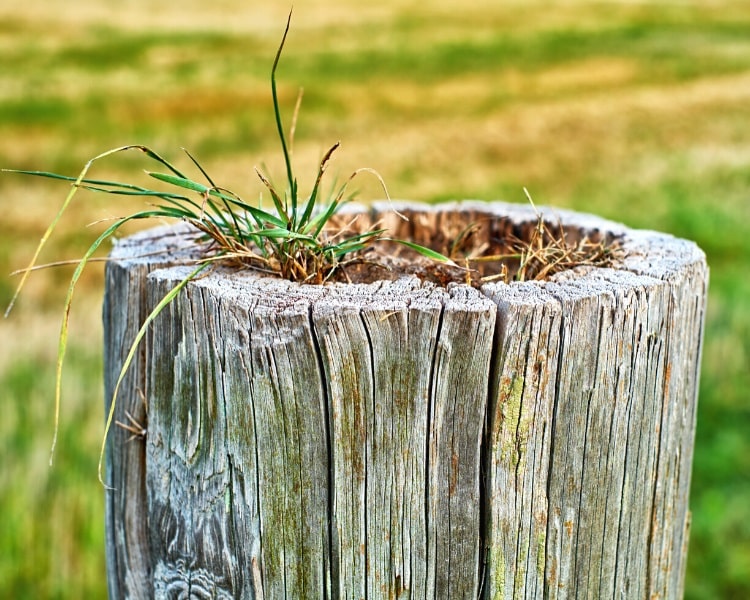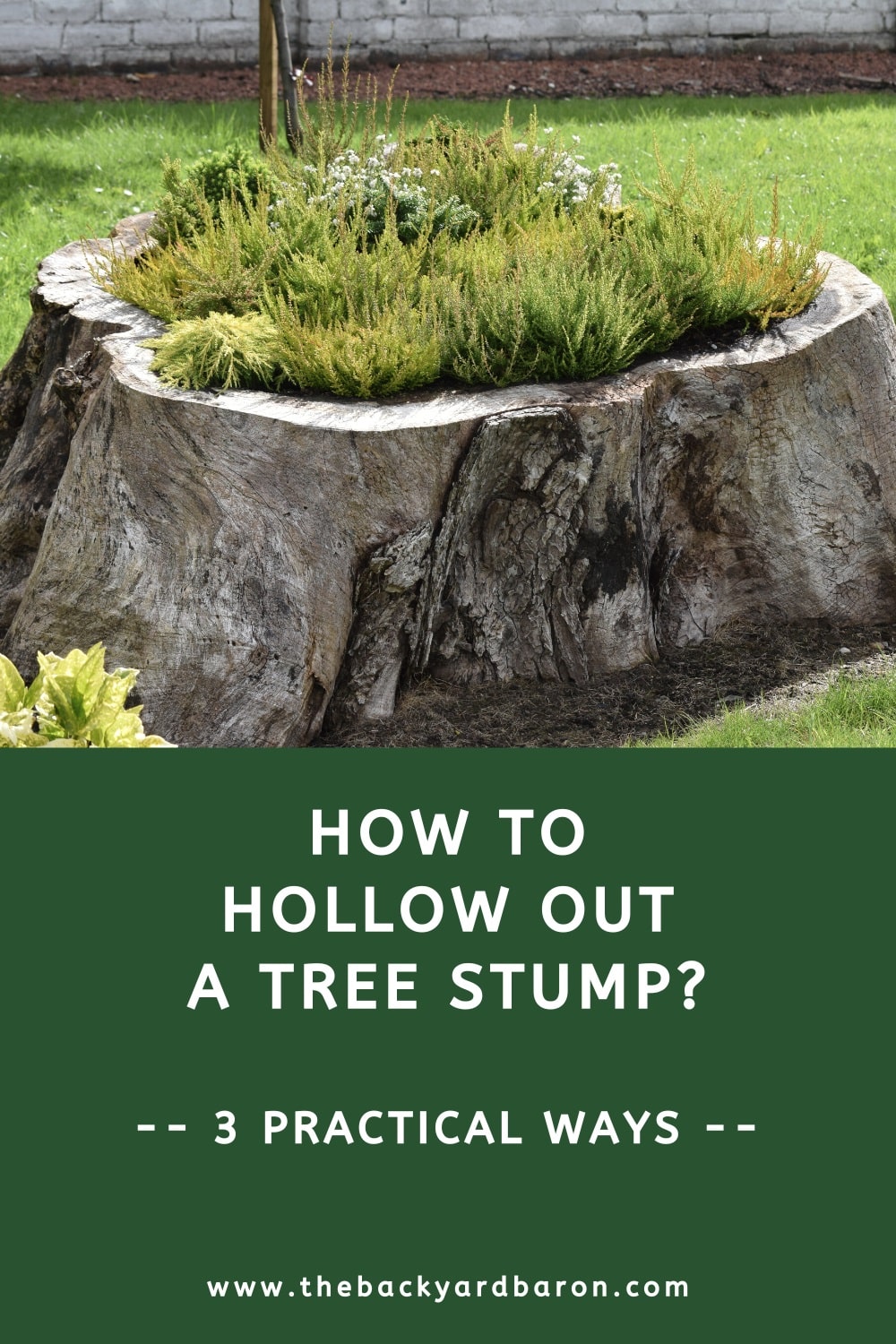Last updated: March 24, 2024
This guide explores three ways to hollow out a tree stump and what you can do with it to transform your outdoor space.
For many home gardeners, a tree stump can be a bit of an eyesore, and the urge to remove it can be hard to resist. But preserving a tree stump and repurposing it into something decorative is worth considering.
If you do have an old stump in your yard, one thing you can do is hollow it out and turn it into a decoration piece.
In this article, I am going to share three ways to hollow out a tree stump:
- Using a chainsaw
- Doing it manually
- Using fire
Why Create a Hollow Tree Stump?
Removing a tree stump can be a time-consuming and often expensive process, whether you do it yourself or let the professionals do it.
Choosing to hollow it out instead can save you time, money, and frustration, and will leave you with an extra decoration item.

Fully removing tree stumps can also disturb the soil in your yard, making it more difficult for other plants to take root. If you live in an area with heavy rainfall, it can also increase soil runoff.
In some cases, completely removing a tree stump may affect nutrient levels in the surrounding soil. The root system may be home to beneficial insects and bacteria that can no longer survive once you remove it.

Because of the risks (and costs) associated with the removal process, it might be safer and more beneficial for you and your yard to keep an old stump in place and put it to good use.
Backyard Decoration
Perhaps the biggest reason one might choose to hollow out a tree stump instead of removing it is to repurpose it as decoration.
There are plenty of ways to turn a hollowed-out stump into a natural-looking decorative object or even something more functional.
Here are some ideas:
- Fill the interior with compost or potting soil to create a unique planter for your garden.
- Create a “gnome home” or fairy cottage by adding tiny accents such as doors, windows, and flowers.
- Use the stump as a pedestal and add a bowl or basin, filling with water to create a backyard bird bath.
- Add a flat surface made of wood, glass, or metal to create an outdoor table.
- Cover or fill the hole and top with a cushion to make a comfortable, all-natural stool.
- Fill the hole and paint the top of the stump to create a ready-to-use outdoor board game such as chess.
The planter idea is perhaps the most suitable purpose for a hollowed-out tree stump. It works incredibly well, looks fantastic, and enhances the backyard experience.

No matter how you decide to reinvent your stump, it’s bound to make a notable addition to your backyard setup.
Tree stump decor works particularly well with rustic, natural outdoor decor schemes, though you can incorporate them into just about any design style.
3 Ways to Hollow Out a Tree Stump
There are a few different ways to effectively hollow out a tree stump, depending on the size of the tree stump you’re dealing with, your level of experience, and your personal preferences:
- Using a chainsaw
- Doing it manually
- Using fire
Let’s discuss these three methods in more detail.
1. Using a Chainsaw
Using a chainsaw is a quick and easy way to hollow out a tree stump, but it’s important to remember to take proper safety precautions.
Each year, thousands of people in the US end up with chainsaw-related injuries. However, as long as you follow basic safety rules, a chainsaw is an effective way to hollow out a tree stump.
Here are the steps:
- Wait until the stump is completely dry, ideally after several days or weeks with no rain.
- Carve out the central area that you want to remove. Use a chisel to remove the top layer.
- Use your saw to separate the wood closer to the base. You may need to carve outwards from the center in a star pattern to create easily removable wood chunks.
- Use your chisel to remove wood pieces, then smooth over rough edges.
If you’re repurposing your stump into something like a planter, you may want to add a drainage duct to your stump to prevent overwatering and rotting.
You can also add a chunk of charcoal to the base of your stump to absorb smells and promote better air filtration, reducing the risk of mold and pests.
2. Doing It Manually
You can also hollow out a tree stump with manual labor and some tools. Using a drill, hammer, and chisel is one of the most common ways homeowners choose to accomplish this.
Most people already have the tools they need waiting in the garage, making it an economical option. Chiseling can be more time-consuming and labor-intensive, but it also tends to be safer, especially for the inexperienced.
Here are the steps:
- First, allow the wood to soften to make it easier to chisel. You can either soak it in water or wait until after heavy rainfall.
- Drill a series of holes around the stump, spacing them through the section you wish to hollow out and remove.
- Using a chisel and a hammer, chip between the drilled holes and remove wood piece by piece. Make sure to keep the chisel at a 45-degree angle for best results.
- Once you’ve removed the bulk of the wood, use your chisel to smooth and clean jagged edges. Make sure to wipe away or vacuum up excess sawdust.
With the hammer and chisel method, you’ll find yourself with a pile of scrap wood at the end of your project.
You can recycle this, compost it, or even use it as free mulch in other areas of your garden. If you have enough leftover material, you may even be able to sell it.
3. Using Fire
Using fire is one of the fastest and cheapest ways to remove or hollow out a stump. However, you need to be careful not to leave chemical residue from any chemical accelerants that you use.
If you live in a dry area, you also need to take steps to make sure the fire doesn’t spread. But overall, using fire is an effective way to hollow out tree stumps.
Here are the steps:
- Remove dry items from the area surrounding the stump, including sticks, leaves, backyard decor made of wood, or other flammable materials.
- Drill a large hole into the center of the stump, working at a 30-degree angle. The hole should be deep enough to reach the roots of the stump. You should also drill more shallow holes on the top of the stump to promote oxygen circulation.
- Fill each hole with an accelerant such as potassium nitrate or kerosene.
- Pile dry scrap wood over the stump and light it. Wait until the fire has mostly burned out and the interior of the stump is gone to douse it.
When working with fire, always keep water on hand in case of emergencies. You should also make sure to thoroughly clean your hands after handling chemical accelerants such as potassium nitrate.
If any seeps into the ground, you may have to extract it from the soil. You can dissolve unused potassium nitrate from inside your stump using hot water.
Final Thoughts
If you have an old tree stump sitting in your yard, you don’t necessarily have to rip it out of the ground. Knowing how to hollow out a tree stump gives you endless possibilities when it comes to transforming your garden.
No matter which method you use, it’s often a cheaper and easier choice than complete removal. What’s more, you can easily repurpose that stump and turn it into a unique focal point in your yard.


We just had an old, unhealthy silver maple removed and the stump had a large area of decay in the middle. I dug out a good part of the softened wood. It goes pretty deep. Can I repurpose it to use as a planter? Do I put rocks in the bottom and then potting soil?
Thank you!
Hi Sue,
Yes, you can repurpose the stump as a planter. Depending on how deep the stump is, you can fill it with compost or potting soil. Rocks may be useful for some extra stability.
Good luck with the project!
Would building up along the edge on top of the tree stump with landscape bricks and filling that in with dirt to make a planter? Without hollowing the tree stump.
Hi Sue, yes that sounds like a good idea.
It might look less natural perhaps, but I would argue it’s worth trying as an alternative approach.
Just want to comment that the method using a drill is a LOT of work and takes a long time. We have a cordless drill that only runs about 45 minutes on a charge, and this project is taking us forever. And ours isn’t even a very big stump!
So all in all, this sounds like a good idea but takes a LOT of effort.
You’re right Kathy, it is a lot of work, hard work, and also time-consuming. It’s good to be aware of the effort before starting such a project.
Thanks for commenting!